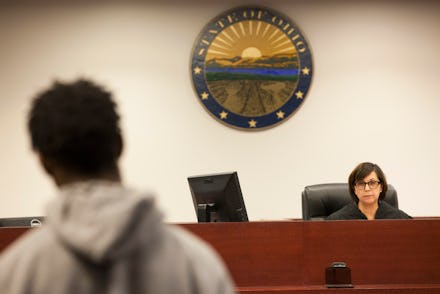A U.N. Report Accuses the U.S. of Torturing Juvenile Criminals. It's Right.

There are 2,500 American citizens serving life in prison for crimes they committed as children, according to The Sentencing Project. Although teenage brains are still "under construction," years away from being developed enough to keep impulsive behaviors in check, these children were tried as adults, allegedly fully aware of the ramifications of their crimes. The United States is the only developed nation to continue the practice of sentencing juvenile offenders to life — and the United Nations has officially condemned it.
In a damning report, U.N. official Juan Méndez lambasted the U.S. for being the only country to give children life prison sentences without parole. The stories of America's children behind bars are staggering, but what really puts this into perspective is Méndez's job: He's the U.N.'s special rapporteur on torture.
And he's got a point. "The vast majority of states have taken note of the international human rights requirements regarding life imprisonment of children without the possibility of release," Méndez wrote in his report. "Life sentences or sentences of an extreme length have a disproportionate impact on children and cause physical and psychological harm that amounts to cruel, inhuman or degrading punishment."
There are international laws regarding freedom, incarceration and punishment to which almost all parties to the United Nations adhere: the International Covenant on Civil and Political Rights, meant to defend right to life, religion, speech, assembly, and due process; the self-explanatory Convention Against Torture; and the Convention on the Rights of the Child, a treaty that advocates the right to life, survival and development of children.
Under article 37(a) of the Convention on the Rights of the Child, no one under the age of 18 can be imprisoned for life without possibility of release. The United States signed and ratified the first two conventions, enshrining them in U.S. federal law. The third, along with its policy on juvenile life sentences, was signed but never ratified.
No child shall be subjected to torture or other cruel, inhuman or degrading treatment or punishment. Neither capital punishment nor life imprisonment without possibility of release shall be imposed for offences committed by persons below eighteen years of age.
The report declares that children deprived of their liberty are at a heightened risk of cruel, inhuman or degrading punishment, and that even very short periods of detention can negatively affect a juvenile's psychological well-being and compromise cognitive development.
Méndez's report argues for the prohibition of torture, not just because it's an absolute human right, but because imprisoned children (and the adults they become) show symptoms consistent with post-traumatic stress disorder and have higher rates of suicide and mental disorder.
And still, 2,500 of them are locked in boxes.
How is this happening? How, even after the Supreme Court ruled juveniles convicted of murder can't be subject to mandatory, parole-less life sentences, is the United States still the singularity in one of the worst possible methods of disciplining a juvenile?
According to a national survey by The Sentencing Project, the deck is stacked against convicted juveniles from the beginning. The survey found that the majority of juvenile life-without-parole sentences were issued in states where judges are required to sentence offenders regardless of age or circumstances. Furthermore, over a quarter of them weren't being directly accused of the crime (e.g., they were charged as an accomplice rather than a shooter in a homicide case).
An overwhelming majority of convicted juveniles had been physically or sexually abused, factors that the report says often influence violent behavior. African-American children were 10 times more likely to catch life sentences without parole than white children. Because of some ludicrous state laws, most of them are incarcerated in just a few states: California, Louisiana, Massachusetts, Michigan and Pennsylvania.
In 2011, Amnesty International released a report profiling three inmates, all incarcerated as juveniles, serving life sentences without parole. In every case, homicide was involved, either directly or in a secondary role. Some inmates, like Christi Cheramie in Louisiana, who went to prison for life when she was 16, try to make the best of the situation with secondary education and teaching classes.
Others crack. David Young went to jail at 17 for being involved in a murder. But secondary education wasn't available to him at the prison. He became isolated, turning to violence for protection and eventually landing himself in solitary confinement.
Both came from broken homes. Neither is a white male from a well-off family, like Ethan Couch, who, at 16, killed four people while driving drunk, and received no jail time.
These are people who need help, not handcuffs, and some of those policies (like state-level government deciding how quickly to throw the life-sentence book at a minor) shouldn't be hard to change.
As a nation, we need to see this from Méndez's point of view. To put a 13-year-old in jail forever, regardless of the crime, is to destroy a life slowly and brutally. When it comes to the incarceration of children, it's time for the country to update its policies.